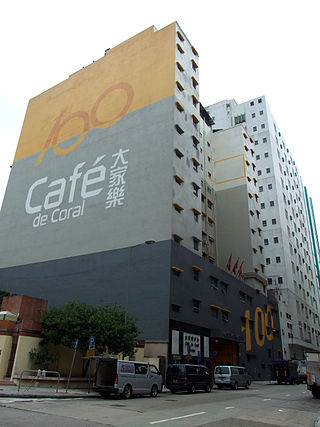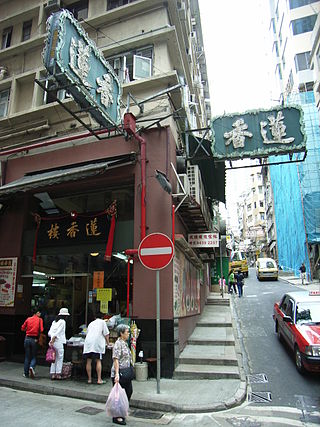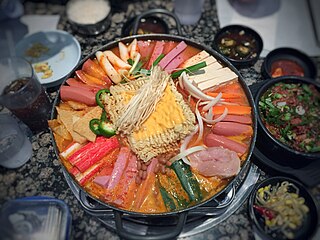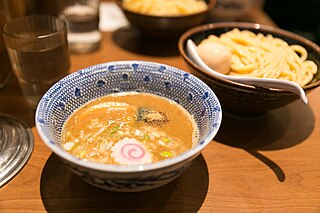Related Research Articles

Cantonese or Guangdong cuisine, also known as Yue cuisine, is the cuisine of Cantonese people, associated with the Guangdong province of China, particularly the provincial capital Guangzhou, and the surrounding regions in the Pearl River Delta including Hong Kong and Macau. Strictly speaking, Cantonese cuisine is the cuisine of Guangzhou or of Cantonese speakers, but it often includes the cooking styles of all the speakers of Yue Chinese languages in Guangdong.

Daikon or mooli, Raphanus sativus var. longipinnatus, is a mild-flavored winter radish usually characterized by fast-growing leaves and a long, white, napiform root. Originally native to continental East Asia, daikon is harvested and consumed throughout the region, as well as in South Asia, and is available internationally. In some locations, daikon is planted for its ability to break up compacted soils and recover nutrients and is not harvested.

Cha chaan teng, often called a Hong Kong-style cafe or diner in English, is a type of restaurant that originated in Hong Kong. Cha chaan tengs are commonly found in Hong Kong, Macau, and parts of Guangdong. Due to the waves of mass migrations from Hong Kong in the 1980s, they are now established in major Chinese communities in Western countries such as Australia, Canada, the United Kingdom, and the United States. Likened to a greasy spoon cafe or an American diner, cha chaan tengs are known for eclectic and affordable menus, which include dishes from Hong Kong cuisine and Hong Kong-style Western cuisine. They draw comparisons to Western cafés due to their casual settings, as well as menus revolving around coffee and tea.

Café de Coral Holdings, Ltd. is a Hong Kong fast-food restaurant group that owns and operates fast-food chains and restaurants, including Café de Coral, Super Super, The Spaghetti House, Oliver's Super Sandwiches, Ah Yee Leng Tong, and others.

Hong Kong cuisine is mainly influenced by Cantonese cuisine, European cuisines and non-Cantonese Chinese cuisines, as well as Japanese, Korean and Southeast Asian cuisines, due to Hong Kong's past as a British colony and a long history of being an international port of commerce. Complex combinations and international gourmet expertise have given Hong Kong the labels of "Gourmet Paradise" and "World's Fair of Food".

Fish balls are balls made from fish paste which are then boiled or deep-fried. Similar in composition to fishcake, fish balls are often made from fish mince or surimi, salt, and a culinary binder such as tapioca flour, corn, or potato starch.

Tong sui or tim tong is a general term for any sweet soup served as a dessert typically at the end of a meal in Chinese cuisine. Tong sui originated in the Lingnan region of China, including Guangdong, Guangxi, Hainan, Hong Kong, Macau, and some parts of other provinces in China. Therefore, in the narrow sense, the term tong sui is used to refer to soupy desserts from Lingnan, while occasionally it is also used in the broad sense, referring to any soupy dessert in Chinese-speaking regions.

Chinese Indonesian cuisine is characterized by the mixture of Chinese with local Indonesian style. Chinese Indonesians, mostly descendant of Han ethnic Hokkien and Hakka speakers, brought their legacy of Chinese cuisine, and modified some of the dishes with the addition of Indonesian ingredients, such as kecap manis, palm sugar, peanut sauce, chili, santan and local spices to form a hybrid Chinese-Indonesian cuisine. Some of the dishes and cakes share the same style as in Malaysia and Singapore, known as Nyonya cuisine by the Peranakan.

Soups in East Asian culture are eaten as one of the many main dishes in a meal or in some cases served straight with little adornment, particular attention is paid to the soups' stocks. In the case of some soups, the stock ingredients become part of the soup. They are usually based solely on broths and lacking in dairy products such as milk or cream. If thickened, the thickening usually consists of refined starches from corn or sweet potatoes.

Hasma is a Chinese and widely Central Asian dessert ingredient made from the dried fatty tissue found near the fallopian tubes of true frogs, typically the Asiatic grass frog. Because of its whitish appearance, hasma is often called "snow frog fat". Hasma is relatively expensive, so it is reserved for special occasions and in high-end restaurants.

Tung Chung New Town, formerly named North Lantau New Town, is the newest of the nine new towns in Hong Kong, a special administrative region of China, located on the northern coast of the Lantau Island in the New Territories. It covers Tung Chung, Tai Ho Wan, Siu Ho Wan, other parts of northeast Lantau Island, and the reclaimed land along the coast between them. It is the only new town in the Islands District and the youngest new town in Hong Kong. As the commercial, residential and community facilities in the New Town are concentrated in Tung Chung, it has been renamed Tung Chung New Town in recent official government documents.

Budae-jjigae is a type of spicy jjigae from South Korea that is made with a variety of ingredients, often canned or processed. Common ingredients include ham, sausage, spam, baked beans, kimchi, instant noodles, gochujang, and American cheese. The dish is now a popular anju and a comfort food cooked in a large pot for multiple people. It also goes by the English names army stew, army base stew, and spicy sausage stew.

Economy rice or economic rice is a type of food or food stall serving many dishes accompanied by rice, commonly found in hawker centres, street vendors or food courts in Malaysia and Singapore. Specifically in Singapore, it is commonly known as cai png, from the Hokkien 菜饭; cài fàn; chhài-pn̄g. In recent times, due to COVID-19 restrictions and its associated economic impact, this concept has also become popular in Hong Kong.

Tsukemen is a ramen dish in Japanese cuisine consisting of noodles that are eaten after being dipped in a separate bowl of soup or broth. The dish was invented in 1961 by Kazuo Yamagishi, a restaurateur in Tokyo, Japan. Since then, the dish has become popular throughout Japan, as well as overseas in the United States.
Dai pai dong is a type of traditional food stall in Hong Kong. The casual, open-air stalls peaked in popularity in Hong Kong during the 1960s and 1970s. The literal meaning of dai pai dong in English is “big license stall”. Dai pai dong can be recognized by their green steel exteriors and serve affordable Cantonese specialties. During their heyday, the stalls served a social hubs where working people would gather to eat and talk. Starting in the 1980s, the government stopped issuing new licenses and began buying them back, citing hygiene concerns and noise and traffic complaints. As elderly dai pai dong owners sold their licenses back to the government or died without being able to transfer licenses to their descendants, most dai pai dong closed down and were replaced by different kinds of restaurants. Urban development has also had an impact on dai pai dong. There are only 25 dai pai dong left in Hong Kong according to the Food and Environmental Hygiene Department, which manages the licenses. Because of the desire to preserve the local food culture, it has been suggested that licenses should be issued again for new and existing dai pai dong owners.

Tim Ho Wan is a Hong Kong dim sum restaurant chain originating from Hong Kong. Known for being "the world's cheapest Michelin-star restaurant", the chain has since expanded and now has franchises in 12 countries.

Kaiseki (懐石) or kaiseki-ryōri is a traditional multi-course Japanese dinner. The term also refers to the collection of skills and techniques that allow the preparation of such meals and is analogous to Western haute cuisine.
The Hong Kong Food Festival is a food festival organised by the Hong Kong Asia Exhibition (Holdings) Limited. It is held annually at the Hong Kong Convention and Exhibition Centre, selling and promoting a variety kinds of food, drinks, snacks and many more. There are different zones for various kind of customers.
Food prices refer to the average price level for food across countries, regions and on a global scale. Food prices affect producers and consumers of food. Price levels depend on the food production process, including food marketing and food distribution. Fluctuation in food prices is determined by a number of compounding factors. Geopolitical events, global demand, exchange rates, government policy, diseases and crop yield, energy costs, availability of natural resources for agriculture, food speculation, changes in the use of soil and weather events directly affect food prices. To a certain extent, adverse price trends can be counteracted by food politics.

North Korean cuisine is the traditional culinary practices and dishes of North Korea. Its foundations are laid by the agricultural and nomadic traditions in southern Manchuria and the Korean Peninsula. Some dishes are shared by the two Koreas; however, availability and quality of Northern cuisine is much more significantly affected by sociopolitical class divides.
References
- ↑ "兩餸一湯指數 街市餸價 兩區可差15%". Life.mingpao.com. Retrieved 13 November 2014.
- ↑ "工聯消息 < 最新消息 < 關於我們 - 香港工會聯合會". Life.mongpao.com. Retrieved 13 November 2014.
- ↑ "兩餸一湯價東區加最多 全港平均年升13.7% 南區買餸最貴". Life.mingpao.com. Retrieved 13 November 2014.
- ↑ "「兩餸一湯指數」菜價年升17%". Jmc.hksyu.edu. Retrieved 13 November 2014.
- ↑ "最新消息 < 關於我們 - 香港工會聯合會". Ftu.org.hk. Retrieved 13 November 2014.
- ↑ "uR@ơv". Paper.wenweipo.com. Retrieved 13 November 2014.
- ↑ "工聯消息 < 最新消息 < 關於我們 - 香港工會聯合會". Ftu.org.hk. Retrieved 13 November 2014.
- ↑ "權益焦點 < 勞工權益 - 香港工會聯合會". Ftu.org.hk. Retrieved 13 November 2014.